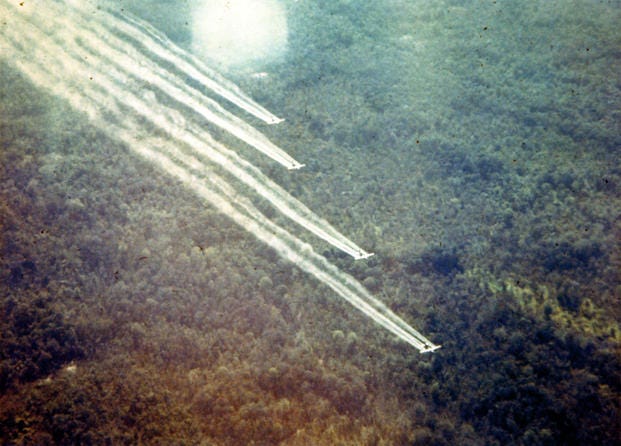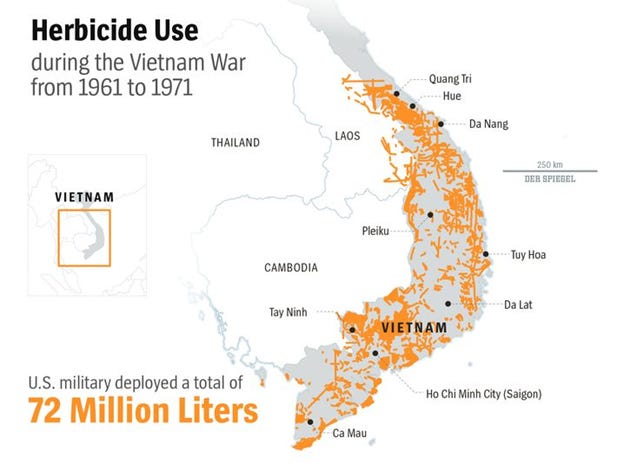There are few things in this world with the long-term toxicity of Agent Orange, the chemical herbicide used in Vietnam. Polonium-210 in a cup of tea will kill you – just ask former Russian spy Alexander Litvinenko – but, unlike Agent Orange, its damage isn’t generational.
For the uninitiated, Agent Orange is the moniker given to the “mixture of butoxyethanol esters of 2,4-dichlorophenoxyacetic acid (2,4-D) and 2,4,5-trichlorophenoxyacetic acid (2,4,5-T).”1 It was a nasty chemical compound manufactured primarily by Dow Chemical and Monsanto (and others) at the instructions of the United States government during the Vietnam war.
From 1962 to 1971, the US Air Force sprayed at least 11 million gallons of Agent Orange in Vietnam. The purpose of Agent Orange, primarily distributed through Operation Ranch Hand, was defoliation to improve visibility for military operations and the destruction of enemy food supplies. It was mostly sprayed by plane, although it was also sprayed through helicopters, truck, boat, and backpacks to clear foliage around bases and landing zones.
What made Agent Orange so dangerous was that during production, a dangerous byproduct formed: dioxin TCDD, a chemical so toxic it damages is calculated not in years but in decades or even centuries.
Dow Chemical and Monsanto knew the risks of Agent Orange and dioxin. In 1965, scientists from four rival chemical companies met at Dow Chemical to discuss the “health hazards of dioxin.” By then, the companies had been manufacturing Agent Orange and other defoliants for the US war in Vietnam. It was agreed upon at this meeting that the toxicity of Agent Orange – which caused “severe” liver damage in animal subjects – would have to remain a secret because the situation might “explode” and “generate a new wave of government regulation for the chemical industry.”
While the chemical companies tried to keep the dangers of the defoliants from the US government, the US government had knowledge of their toxicity all along. In 1963, just a year after Agent Orange started being sprayed in Vietnam, the government knew “dioxin caused birth defects in mice.” There is also evidence that the highest levels of the US government knew in 1967 that Agent Orange could kill the innocent:
In 1967 Secretary of Defense Robert S. McNamara referred to the Joint Chiefs Staff a consultant's report that said the fear of Vietnam peasants about the toxicity of Agent Orange “was founded partly on actual experiences, not solely on Vietcong propaganda.”
The US government and the chemical companies were largely successful in keeping this information from the American public. The war effort – and corporate profits – could not be sacrificed for public health.
As the years passed, it became apparent, through mere observation alone, that birth defects and serious health problems were linked to Agent Orange. In the early 1980s, Dow Chemical and several other chemical companies were sued by more than “20,000 Vietnam veterans, their widows and their children.” Dow Chemical pointed the finger at the US government, arguing they were immune from liability as government contractors because acted in accordance with government instructions.
Now the US government was in a dilemma. The problems caused by Agent Orange – including devastating effects on health and heartbreaking birth defects – were going to be expensive. Lawsuits would be filed, there would be Congressional hearings, and veterans’ benefits (obligations to veterans and their families) would cost billions of dollars.
And so the Centers for Disease Control (CDC) helped cover it up.
By the mid-1980s, nearly 35,000 Vietnam veterans claimed to have “suffered cancers and skin diseases and fathered children with birth defects as a result of exposure to Agent Orange.”
In 1987, the CDC halted the evaluation of veteran exposure to Agent Orange, stating records were insufficient to determine the troops that had been exposed to the chemical. In the CDC’s own words: “It is unlikely, therefore, that military records can be used to identify a large number of US Army veterans who might have been exposed to [Agent Orange] in Vietnam.”
Instead, the CDC looked to the then-current levels of dioxin as an “indicator to exposure” – and concluded “that few Army ground troops had been heavily exposed to herbicides in Vietnam or elsewhere.” From this result the CDC decided against probing the study further.
Scientists called bullshit. Testifying before Congressional subcommittees, they stated “military records do exist and show which Army companies were in areas sprayed by the herbicide.” Their own statisticians said CDC records were falsified and that the agency was warned they were “doing bad science.”
In the words of former Air Force Scientist Dr. Richard Albanase, “These people really bent over backwards to try to disprove a connection” between birth defects and Agent Orange.
All this was the enabled, in part, by compromised CDC leadership. At the time, Dr. Vernon Houk was the director of the CDC’s Agent Orange study and head of the CDC’s Center for Environmental Health and Injury. Dr. Houk turned out to be “source of many news articles disclaiming the dangers of dioxin. . . Houk was also responsible for derailing the CDC Agent Orange Study.”2 He had such a cozy relationship with corporate interests that he “admitted that in his proposal for relaxed dioxin standards, he copied word-for-word reports given to him by the paper industry.”3
While these studies were cancelled due to alleged insufficient data, other studies were used to downplay the link between Agent Orange and birth defects.
In 1984, despite increases in exposure-related diseases, the Air Force was vouching for the safety of Agent Orange and supporting its future use:
“No early diseases, no big diseases, are showing up,” said Maj. Gen. Murphy A. Chesney, who added that he would be confident about using Agent Orange in another war. “It saved thousands of lives,” he said, “and so far we've seen nothing that makes us think we shouldn't have used it.”
Not soon after that report, the CDC concluded that “with few exceptions, the estimated relative risks of Vietnam veterans' fathering babies with defects in the remaining 95 defect groups were similar.”
The Truth
Despite government assurances, the reality was that Agent Orange left a legacy of generational damage. Many victims of the Vietnam War were born after the war ended.
Due to their parents’ exposure to US herbicides, there are children in Vietnam who will not know a life without suffering. Some can’t see because they have no eyes. They can’t walk because they have no feet. They can’t count to 10 because their brain can’t process the concept of numbers. The photographs are haunting.
And in America, these studies from the CDC and other governmental agencies were used to deny benefits to children of US veterans born with birth defects. According to a 2016 investigation by ProPublica and The Virginia-Pilot, US government conclusions about causation of these defects left out “the vast majority of vets’ ailing children.”
This included children born without limbs and holes in their hearts, and those who entered this world with permanent brain damage. The children of Vietnam veterans who, in large part, have also been wrongly denied benefits.
Dying from Dioxin (1999).
Id.






Wish I had this when I was telling my school board we should stop considering any suggestions from the CDC last night. They decided to mandate masks for age 12 and under. Gotta have a carrot for parents to get kids vaccinated when it's approved. Unenrolled my kids this morning. Sending them to school, literally in a barn, that teaches Latin and the constitution. Thanks Tech.
I was an Infantry soldier on and inside the Korean DMZ in 1968-1969. In that area, not only was Agent Orange used, but also Agent Blue which was Crystalized Arsenic, which causes COPD breathing problems. I know, because I am rated 90% disabled and paid at 100% permanent disability because I am unable to hold down any employment due to other "chemical-related exposure" while in South Korea. Agent Orange and Agent Blue were but two of the many chemicals tested and used in the Korean DMZ area in the 1960s and on. We call them the "Rainbow Color" of chemicals. Soldiers stationed in Korea years afterward are still coming down with diseases related to these chemicals. My illnesses turned up 40 years after I left Korea, have shortened my life by at least 10 years, and made the past 12 years very difficult, frustrating, and depressive to me. But I am a survivor, and I still am fighting for my deceased brothers, their widows, and their children. My first child died 4 months after conception and was stillborn, and 15 years ago I had a grandchild born with numerous cancers, which he luckily survived. These agents were used on military bases and many other locations before they finally were stopped, but the damage was already done. Military camps in South Korea to the north of the capital, Seoul, have been turned over to the Korean Military. When inspected, many were found to be unusable, with the groundwater and the soil still showing signs of chemical saturation. This is 50 years AFTER the areas were sprayed on the ground surfaces. The military told us it was harmless to us, but they lied. Now we are left, being denied our claims and forcing us to appeal their denials, time and time again. I currently have a claim that is over 6 years old, awaiting a final VA judge to decide my fate. Many have given up, many others have died, leaving their widows to fight with the VA. Sgt. Den